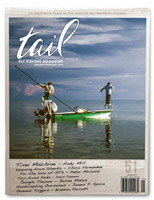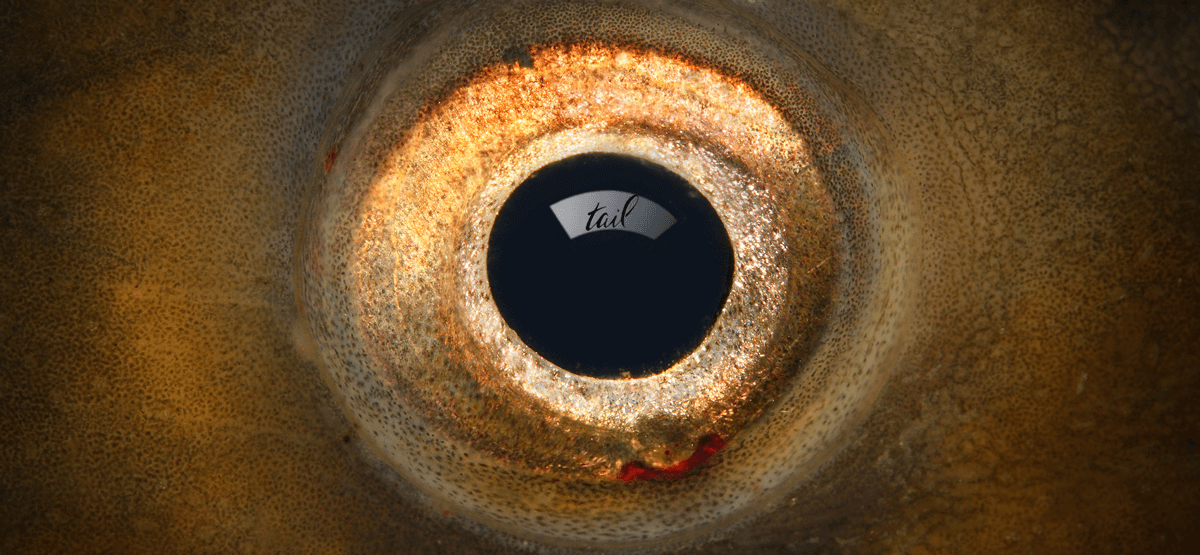Whether sparked by yellow chalk scratching through first-grade fog or the Clark Kent spectacles that transformed that fog into a chalkboard with instructive writing or the parental insistence that my amblyopia would correct itself if only I would make my lazy eye sit up straight and look where it’s going and wear its embarrassing eye patch, I’ve always envied people who can see the hard-to-see.
Especially fish, which are harder to see than practically anything more corporeal than ghosts and leprechauns. Who hasn’t heard the defeated tone of a guide on the bonefish flats who realizes that no matter how many times he says, “Ten o’clock, Sixty feet, Three big bones tailing left to right,” his dimwitted sport will cast to the three mangrove shoots six feet astern?
But it isn’t entirely our fault. Prey species are forever contriving unfair ways not to be seen. Brook trout disappeared into the dappled green forest streams by evolving backs covered with forest-green dapplings. Bonefish got themselves chrome-plated to reflect the shining expanse of skinny tropical flats straight back into hostile eyes. Small soft creatures like herring flock together with thousands of other small soft creatures—all of them saying, “Eat them, not me,” and most of them getting away with it. Species that grow from toothsome young prey into large toothy predators look for hangouts where even larger and thoothier predators won’t prey on them.
Take striped bass and flats, for example. When stripers were young and tender, ospreys and herons made skinny sunlit flats into dangerous neighborhoods. But when they reach a certain size stripers no longer fear aerial assault, and the shallow clear flats are mostly free of the seals and sharks and stern trawlers and soft-plastic Slug-Gos that can make deeper, faster water nervously unrestful, even for a fifty-pounder.
As most saltwater fishermen know, striped bass are creatures the twilight, of movement, of tide rips and swirling bait schools and crashing surf. This makes striper anglers creatures of pre-dawn departures and midnight shoreline stumbles and of live-lining mackerel, deep-drifting eels, and tolling plugs the size of policemen’s nightsticks. Fly-fishing for stripers, like the striper itself, is pure brutality: heavy depth-charge fly lines and ginormous flies and rod-shattering strikes and enough adrenaline to turn a pack of PETA pacifists into foie-gras-eating ax murderers.
Which is why a rippled expanse of alluvial ooze overlain by a few feet of transparent seawater is about the last place a standard-issue striper fisherman might look for a striper, especially with the sun burning high in a cloudless sky.
But that’s exactly where we went looking for them, we being fish-mag editors Dave Klausmeyer and Joe Healy fishing with Eric Wallace and Mac McKeever on a skinny backwater flat on a bright sunny day—the very time when normal Maine striper fishermen were snoozing in the shade after having flamed out on a dawn tide in one of the big brackish rivers or along the near-shore islands, casting into the rips and the surf while jockeying for position with all those other boatloads of coffee-cranked striper fishermen casting into the rips and the surf.
Out there on the windless late-morning flats, it was just us and the sun and the seagulls and the gray stern granite and green pointed firs hemming a small secluded cove. Joe and I fished with Eric, one of only a few Maine guides who specialize in flat-fishing for stripers, and it was a dislocating experience. I’d look back from the postcard view of coastal Maine to see Eric up on the poling platform with his sunblock and sunglasses and, “Get ready, good fish at two o’clock about sixty feet off.” I’d narrow my eyes and roll them around, and slowly a striper would materialize. And then I’d snap out of my no-worries-mon Bahamian bonefish trance and launch a mighty dawn-patrol striper cast that hit the water like an osprey and scared the bejesus out of that striper, then we’d ghost along looking for another to frighten away, with me chanting under my breath, “I’m bonefishing for stripers, I’m bonefishing for stripers. Everybody say Aummmmm.”
Along with nurturing my inner calm, I was also trying to remember the mechanics of spotting fish. You do this, as anglers all should know, not by looking for fish—stripers, with their mirrored sides traced by waving lines, can be as invisible as baby bonefish even when pushing forty pounds—but by looking for the suggestions of fish. At a distance, you see not the striper but the impression of a striper: its shadow on the bottom, the flick of a fin, the flex of a tail, the dart of a jaw snarfing a green crab, grass shrimp, or sand eel.
Compared with the hyperactive tent revival of striper fishing in the surf, sight-fishing the mirrored flats is Zen: the quest becomes its own reward. Like dry-fly fishing, it’s a form of aesthetic self-denial that slows your pulse and makes you see.
But it isn’t a way to run up numbers. For the day, we each boated one fish and lost another. With a dawn assault on a big tidal river, that would be an official defeat. But for flats fishing in Maine it was a success—and possibly the birth of an addiction.
There’s always a genesis moment when something new materializes from the fog. Angers to the south wont see fly-fishing the flats for stripers as anything new—the big flats off Cape Cod’s Monomoy Island or Long Island’s Great South Bay have long been home to a minority cult of flats-fishers. But here in Maine, stripers on the flats have been pretty much invisible, and fishing for them the way they need to be fished for, which is to say slowly and carefully without even a trolling motor’s cautioning whisper, is beyond novel.
Mac McKeever, the senior PR wallah at L.L. Bean, is the first person I know to have done it., though I know other people who were rumored to have done it but didn’t want anyone to know. Like most significant discoveries, Mac’s was an accident.
“Ten or so years ago,” he said, I was pulling my skiff at a boat ramp, and a telephone worker was having lunch and asked how I did. I told him I’d caught a few fish here and there, and he said he was working high atop a pole at a nearby bluff overlooking a shallow white sand flat, and he’d seen loads of fish milling around in the skinny water. I went over there, and sure enough, the flats were haired over with the things—some big ones, too! I’ve been on them ever since, at first climbing atop coolers and then library step stools or teetering on the outboard’s cowling to try for a better vantage point to spot fish.”
Finally Mac got a proper poling platform made for his sixteen-foot Aquasport, and now he spends his days fishing the Pine Tree State Caribbean-style: long light leaders, little crab flies, and clock-face casting. “Pretty neat stuff,” Mac says. “Clear shallow water, light sand, and black-backed stripers hunting for crabs.” And a few—a very few—anglers on the flats hunting for stripers.
A year later, Jerry Gibbs and I met Mac at a different beach—his original beach, the lineman’s beach—at the leisurely hour of half past eight, a time dictated in part by the high-noon low time and more significantly by the sight-fishing necessity of high flooding sunlight. Which, as is typical with a trip planned well in advance, didn’t arrive.
With intermittent cloud cover and the hot southern breath of a looming storm, even Mac had difficulty spotting fish before they spotted us. Through the morning we saw more than thirty stripers, most past twenty inches and a few past three feet. I managed a cast to only one taking fish, and when he turned on the fly with his open mouth, he spotted the boat fished like a partridge. The lesson: flats-fishing for stripers is a chose-your-day kind of thing. If the weather’s right, you go; if it isn’t, you do something else. Unless you’ve driven 125 miles through coastal Maine tourist traffic to fish. Then, you go anyway.
And I learned another lesson: Stalking those fish and getting that single, turning, almost-a-take in skinny transparent water was as exciting as dragging a dozen depth-charged stripers from the foaming deep. Perhaps that’s a personal vision not everyone can see. But then, not everyone needs to.
A few weeks later, sparked by a near connection with what was here along, if only blinkered eyes could see, I revisited a few neglected flats not far from home, where, bluff-top observations with high-powered binoculars revealed drifting shadows too big to be mackerel and too reposeful to be sturgeon.
In just the right light, I could envision a big Hudson Bay freighter canoe ghosting along with its motor kicked up beneath a simple poling platform made from aluminum pipe bent in a friendly nearby muffler shop, a scrawny old man leaning on a long black push-pole and shading his eyes from the noonday sun. He sees something moving, eases the pole into its rest, and then slowly lifts his fly rod and casts.
It might be a good striper in my vision—I hope so, anyway. or it might be a stick of pulpwood drowned in the mudflat since river-driving days. It probably doesn’t really matter. In either case the electric anticipation is pretty much the same.
Bio: James R. Babb is editor emeritus of Gray’s Sporting Journal. He is the author of four collections of angling essays, the most recent of which is Fish Won’t Let Me Sleep (skyhorsepublishing.com).
 SUBSCRIBE TO TAIL FLY FISHING MAGAZINE
SUBSCRIBE TO TAIL FLY FISHING MAGAZINE


